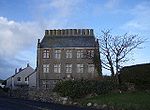Foulney Island
Foulney Island is a low-lying grass and shingle area 1 mile (1.6 km) to the south-east of Roa Island, off the southern tip of the Furness Peninsula in Cumbria, England. Foulney Island is one of the Islands of Furness in Morecambe Bay, northern England. For local government purposes the island is in the borough of Barrow-in-Furness. It has an area of about 40 acres (16 ha). In earlier times it was known as Fowle Island. The island is connected to the mainland via a shingle and rock causeway which was built in Victorian times as a tidal protection measure. The Foulney causeway leaves the Roa Island causeway halfway along its length on the eastern side. The maximum elevation on the island is no more than 10 feet (3 metres) above the high tide level. At the time of highest tides much of the island can be inundated. There are no permanent inhabitants on the island.
Excerpt from the Wikipedia article Foulney Island (License: CC BY-SA 3.0, Authors).Foulney Island
Geographical coordinates (GPS) Address Nearby Places Show on map
Geographical coordinates (GPS)
| Latitude | Longitude |
|---|---|
| N 54.066689 ° | E -3.151488 ° |
Address
Slictch Ridge
LA13 0PX
England, United Kingdom
Open on Google Maps








